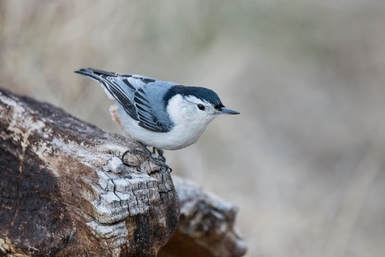 Just now I had a White breasted Nuthatch visiting on the porch railing near the garden wall where I have placed sunflower heads to dry. My guess is that he was curious about the new additions. His little chirps sounded like he was excited about something! The jays have returned and I think they are intimidating the Nuthatch family, so I may put up another feeder closer to the house. White breasted Nuthatches are easy to identify. They are larger than the other nuthatches with a sharply defined white face, a narrow dark crown, and a very long bill. With a short broad tail they are mostly gray and white in color. All summer long I have had them feasting at my bird tree with its squirrel proof feeder. I never tire of watching these spritely little characters climb up and down the branches to take a seed or two before disappearing into the greenery. This year I was fortunate to have witnessed the nuthatches raise a family of four little nuthatches in a tree not very far from the bird tree. This is not a large tree although it has a generous canopy and I will be curious to see where the nest is located when the leaves fall. Most sources say that they nest in tree cavities… so I will have to wait to see. All summer the little ones flew between the nest tree and the bird tree – all day long! When the babies first fledged it took them awhile to figure out how to land on the edges of the feeder. I am delighted to see that the whole family is still here, especially since it is mid September and seeds and grasses of all kinds are available for these little birds to feast upon. Apparently their preference for sunflower seeds has kept them around. Soon, I hope, it will be cool enough to put out suet. As a bird watcher I am a lover of suet and fat because it draws some of my favorite little birds – nuthatches, chickadees, and woodpeckers in for a feast even during the fall. I would like if possible to keep this nuthatch family with me all winter. I love watching them carry away seeds to hide in crevices of trees. White-breasted Nuthatches forage up, down, and sideways over tree trunks and around large branches, which is why it is easy to lose time watching these little birds. They are small aerial acrobats turning upside down with ease to peck suet over their heads. In fact climbing upside down is a distinctive trait of this species. They often start high in trees and move down them head first, pausing to crane their necks up and back, toward the horizontal, for a look around. They probe into bark crevices or chip away at wood to find food. When they find large nuts and seeds, they jam them into the bark and hammer them open. White-breasted Nuthatches often store seeds and insects one at a time, and somewhat haphazardly, under loose bark on their territory. They typically hide the food by covering it with a piece of bark, lichen, moss, or snow depending on where they live. According to the literature they live in pairs year round and chase other nuthatches from their territory. Does this include their offspring? I am curious to see if the family will eventually disperse. Agitated birds fan their tails, flick their wings, or raise their feathers. A bird backing down from a confrontation typically raises its bill and tail, and droops its wings. White-breasted Nuthatches are birds who prefer mature woods, and they’re more often found in deciduous than coniferous forests. They also inhabit woodland edges and in open areas with large trees like the area around my house. They can also be found in parks, wooded suburbs, and yards. During the warmer months they supplement their seed and nut diet with insects, including weevil larvae, wood-boring beetle larvae, other beetles, tree hoppers, scale, ants, gall fly larvae, caterpillars, stinkbugs, and click beetles, as well as spiders. What I didn’t know was that they also eat corn. Their song is distinctive; soft whistling notes with a single pitch. Some sources indicate that their calls vary region by region. What I know from personal experience is that the white breasted nuthatches in Maine sound exactly like the ones in New Mexico. Audubon considers this species climate threatened. It’s important to recognize that drawing these little birds to our feeders helps protect the trees that are infested with damaging insects, so next time you see a White -breasted Nuthatch remember to say thank you for the trees!
4 Comments
Gary Pikarsky
9/28/2018 10:59:03 am
The past two weeks we have seen nuthatches at our feeders I believe for the first time this year. Also a Flicker has been around the past few days. We live up high on Serra Negra.....it seems like most of the colorful birds stay down by the river where there is more shelter and food sources.......I enjoy reading your articles !
Reply
Sara Wright
10/8/2018 10:35:06 am
Thank you! It's lovely to know that people appreciate these observations!
Reply
Joy Nagle
9/28/2018 12:19:19 pm
Sara,
Reply
Sara Wright
10/8/2018 10:37:39 am
Most people don't seem to care about toads so I love meeting another Toadwoman!
Reply
Your comment will be posted after it is approved.
Leave a Reply. |
Submit your ideas for local feature articles
Profiles Gardening Recipes Observations Birding Essays Hiking AuthorsYou! Archives
October 2025
Categories
All
|
 RSS Feed
RSS Feed